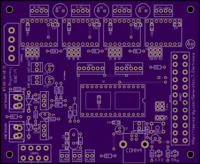OSH Park
Profile for WarHawk-AVG
Shared projects
AlxSmith JouleThief - WarHawk Tweak
by
2
layer board of
2.25x0.67
inches
(57.10x17.09
mm).
Shared on
June 23rd, 2016 04:37.
AlxSmith JouleThief - WarHawk Tweak
Original share here
Same design, I just made the traces larger, made the holes VIA’s (battery holder is rock solid now and doesn’t rip traces off the board so easily), and shrank the board a bit to fit the overall size of the AA holder, and a few minor cosmetic tweaks
Schematic shows BC548 transistors, but you can also use PN2222A transistors you just have to put them in backwards as the B/C/E is reverse from the BC548’s (thus the labeling of the BCE on the board)
The thruhole design makes the retention of the components MUCH stronger than the original design that relies upon just the copper pour for keeping the traces on the board, I have built 6 of these, they run for 7~ days on a fresh battery, and over 3 days on a .9vdc (considered dead) battery at enough light to see fairly well by
Kudo’s to Alex Smith on his original design
BOM:
R1, R3 = 1K 1/4W RESISTORS - CF14JT1K00CT-ND
R2 = 2K2 1/4W RESISTOR - CF14JT2K20CT-ND
L1 = FIXED INDUCTOR SMD MOUNT 470uH - 595-1353-1-ND
C1 = 470PF CERAMIC CAP - BC2681CT-ND
C2 = 100uF ALUMINUM CAP - 399-6600-ND or any stumpy 100uf capacitor stumpy C2
TRANSISTORS = BC548 or if mounted backwards PN2222A - BC548BTACT-ND or PN2222AD26ZCT-ND
LED and LED HOLDER = HIGHEST Millicandela Rated 5MM ROUND DOME LED YOU CAN FIND, AND HOLDER TO MAKE IT LOOK CLEAN ON THE BOARD
BATTERY HOLDER = 1CELL AA PC MNT - 36-2460-ND
Gen7 Board-ARM v2.0 reprap
by
2
layer board of
4.35x3.56
inches
(110.52x90.53
mm).
Shared on
June 16th, 2016 05:58.
A well documented DIY ARM based reprap 3D printer controller board
- LPC1114FN28 MCU, a 32-bit ARM CortexM0+.
- Onboard USB-serial adapter, implemented with an MCP2200.
- Support for up to 4 stepper drivers in the “Pololu format”.
- Support for extruder and heated bed.
- Support for two SPI devices (e.g. SD card and display).
- Support for always-on fans (5, 7 or 12 volts).
- No power supply wiring neccessary, just plug an unmodified ATX supply in and be ready.
- Software power on/off.
- Oversized high current tracks and MOSFETs for reliable, cool operations.
- Board size 110 x 90 mm.
2 layer board of 4.35x3.56 inches (111x91mm). $77.50 for three.
micro.modem.nano.v0a1
by
2
layer board of
0.67x1.67
inches
(17.04x42.44
mm).
Shared on
March 7th, 2016 02:01.
micro.modem.nano.v0a1
2 layer board of 0.67x1.67 inches (17x42mm). $5.60 for three.
Atmega328p-based 1200 Baud AFSK radio modem
MicroModem MicroModem is an open-source implementation of a 1200-baud AFSK / Bell 202 modem on the popular ATmega328p microprocessor. MicroModem can be used for things like ham radio APRS, AX.25, TCP/IP over SLIP, experimentation with mesh-networks, long-range wireless communication with sensors (Or friends! Or strangers!). It basically comes in two flavors: Prebuilt or DIY.
It is simple enough that, if you have some basic electronics experience, you can understand and build it yourself with a few components and an Arduino. You can also get a more advanced and prebuilt, fully tested MicroModem directly from original designer. He manufacture them personally, to the highest quality. (link/store at his site)
Please note that the resources listed here for building your own MicroModem are for an earlier, more simple version, than the one he currently offers for sale. While the two modems are functionally identical, the version he offers for sale has some technical refinements, and is implemented as an integrated board with MCU, USB and everything on one board, measuring only 3×5 cm. The DIY version is a board with all the external circuitry needed for turning a standard Arduino (or compatible like Microduino) into a MicroModem!
This is my adaptation of the MicroModem DIY, it is upsized to the footprint of the arduino nano (I got one for $2.99 vs the $18 it would take for the MicroModem Core USB), this is a conversion and should be a 1-1 pinout match for Marks MicroModem (so his pre-compiled hex files should work with no modification or need for re-compile) but for the MUCH cheaper arduino nano.
Correction for missing trace, and for the used arduino nano library to correct reversal of analog pins.
-untested- at the moment
Baofeng UV5R TRRS Thru-Hole Adapter - WarHawk's Tweak
by
2
layer board of
1.93x0.36
inches
(49.02x9.12
mm).
Shared on
February 5th, 2016 13:53.
Baofeng UV5R TRRS Thru-Hole Adapter - WarHawk’s Tweak
2 layer board of 1.93x0.36 inches (49x9mm). $3.45 for three.
Thru-Hole adaptation of johnboiles KK6GIP - Baofeng UV5R TRRS Adapter
Converted to standard size .25 watt resistors, small tantalum caps will work fine, and made the wires between the pads and holes much thicker, along with a few small cosmetic tweaks.
Baofeng UV5R TRRS Adapter - WarHawk's Tweak
by
2
layer board of
1.08x0.32
inches
(27.36x8.15
mm).
Shared on
February 5th, 2016 12:43.
Baofeng UV5R TRRS Adapter - WarHawk’s Tweak
2 layer board of 1.08x0.32 inches (27x8mm). $1.70 for three.
Adaptation of johnboiles KK6GIP - Baofeng UV5R TRRS Adapter
I made the pads 0805, to make it a bit easier to hand solder with an iron (it’s NOT easy with 0603 components…ask me how I know), and made the wires between the pads and holes much thicker, along with a few small cosmetic tweaks









